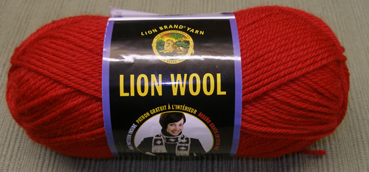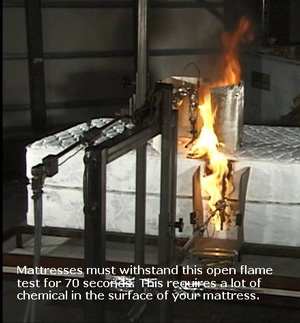|
Wool Burns
Organics Burn
Many mattresses who claim to be "Organic" say
they use wool as the flame barrier. While wool would pass the old cigarette
test for mattresses, it will not pass the new open flame test. These
mattresses either use chemically treaded wool, another chemical system, or rely on
chemically treated cotton batting (Boric Acid and Antimony) to pass the open
flame test.
There are no natural, chemical free, or
nontoxic
systems that pass the severe open flame test. Even what they call
"inherently fire resistant" fibers contain chemicals in the fiber itself. There are no labeling
requirements for the FR chemicals in mattresses. Thus, most mattress
manufacturers deny using chemicals. It is unfortunate that even
"Organic" mattress makers often claim to use no chemicals when a
prescription mattress would be chemical free.
Wool Burn Test
 |
 |
 |
 |
 |
 |
| 2 Seconds |
6 Seconds |
10 Seconds |
14 Seconds |
18 Seconds |
20 Seconds - Gone |
Test performed with commercially available
wool, you can repeat this test at home:


Lion Brand Wool
Relative summary of the
flammability properties of fibers:
| Fiber |
Heat of Combustion
(Kcal/g) |
Ignition Temperature
(°C) |
| Cotton |
3.9 |
255 |
| Rayon |
3.9 |
420 |
| Nylon |
7.9 |
575 |
| Polyester |
5.7 |
560 |
| Wool |
4.9 |
600 |
| Zipro Wool (Treated with
Zirconium, a heavy metal) |
- |
- |
Source: Commonwealth Scientific and Industrial
Research Organization (CSIRO) (Australia)
http://72.14.205.104/search?q=cache:Ugjs_oDjrlMJ:www.csiro.au/files/files/p9z9.pdf+Zirpro&hl=en&ct=clnk&cd=16&gl=us
A Propane torch like used in the mattress
open flame test has a temperature of 1,980 (°C) or 3,596 (°F)
http://en.wikipedia.org/wiki/Adiabatic_flame_temperature

You can see in the table above that wool or any untreated
fiber including cotton, rayon, nylon, or polyester will not pass the open
flame test for mattresses. The flame temperature is more than three times that
required for ignition. Plus you can see proof in the burn photos above or
with your own test.
There are two ways, and only two ways, to
make a fiber fire resistant: 1) Coat the fiber with FR chemicals, 2)
Manufacture the fiber with FR chemicals incorporated into the fiber itself.
These are called "inherently fire restraint" fibers.
The US Consumer Products Safety Commission
(CPSC) did not want the public to know the FR chemicals contained in
mattresses (they are all scary), so there are no labeling requirements.
Mattress manufacturers do not want to admit
using chemicals so they say "we use a natural system" or "we use wool" or
"we use 'inherently fire resistant' fibers." Again, 'inherently fire
resistant" fibers contain chemicals, such as Antimony in the fiber itself in Modacrylic fibers.
Another popular inherent system they try to
call 'Rayon' contains Silica Glass (a respiratory hazard) and other
chemicals such as Phosphates or Antimony. You can see untreated Rayon burns
in the table above (Also See
CPSC Table of
Chemicals in Mattresses)
Some fireproofing systems spray or apply
chemicals. The CPSC says there are some chemical free systems, meaning the
inherent systems. This double talk is very misleading because even the
inherent systems have toxic and cancer causing chemicals in the fiber
itself. The CPSC proved Antimony leaches out of these fibers and says we
will absorb .8 mg Antimony every night from mattresses, this is 27 times
more than the EPA says is safe. (See
Mattresses Toxic by 27X)
From a Patent on making wool and natural fibers
flameproof: "The present
invention concerns methods of inhibiting the burning
of natural fibers (e.g., wool, wool fibers, animal hair, cotton), synthetic
fibers (e.g., acetate, nylon, polyester, viscose rayon), or blends thereof
(e.g., wool/cotton blends), or fabrics or yarns composed of natural fibers,
synthetic fibers, or blends thereof, involving treating the fibers (or
fabrics or yarns) with polyamic acid or at least one polyimidesiloxane or
mixtures of polyamic acid and at least one polyimidesiloxane."
"Conventional chemical
treatments to confer flame resistance to wool include treatment with the
flame retarding agents applied to cotton, such as salts of borate,
phosphate, metals, and tetrakishydroxymethyl phosphonium, and titanium
compounds. Zirconium complexes under the trademark Zirpro™, issued by
the International Wool Secretariat, are one of the successful flame
retardants for wool. Many modifications of the Zirpro™ process according to
specific needs have been made. For example, tetrabromophthalic acid (TBPA)
is used along with Zirpro™ to obtain low heat release wool. However,
zirconium salts have the environmental disadvantage of zirconium being a
heavy metal."
http://www.freepatentsonline.com/7264637.html
From "Commonwealth Scientific and Industrial
Research Organization (CSIRO):"
"The evolution of increasingly severe
mandatory flammability regulations in many aspects of domestic, social and
business life has meant that even inherently low flammability fibres, such
as wool, require a flame retardant treatment for some applications. Typical
applications subject to mandatory flammability requirements include
children's nightwear, domestic and commercial furnishings, public
transportation and protective clothing. … "
"The flame resistance of all textiles,
including wool products, can be improved by selected chemical treatments.
Initially, fire retardant treatments for wool were based on the impregnation
of borates, phosphates and to a limited degree the organic phosphorus
compounds more commonly associated with cellulosic fibres. The introduction
of stricter flammability requirements for airline furnishings resulted from
a review of general aviation standards coinciding with the release of wide
bodied aircraft in the early 1970's. Many flammability treatments available
at the time did not satisfy the new requirements, so The International Wool
Secretariat developed a new flame retardant treatment based on the reaction
of zirconium or titanium salts with wool. A suite of treatments, based on
these two actives, was eventually developed under the generic title of “Zirpro”,
to cover a variety of flammability standards and care claims."
http://72.14.205.104/search?q=cache:Ugjs_oDjrlMJ:www.csiro.au/files/files/p9z9.pdf+Zirpro&hl=en&ct=clnk&cd=16&gl=us
There are no natural, chemical free, or
nontoxic mattresses that comply with the federal regulation. They all
contain toxic chemicals. Your only choice for a chemical free mattress is by
prescription.
|